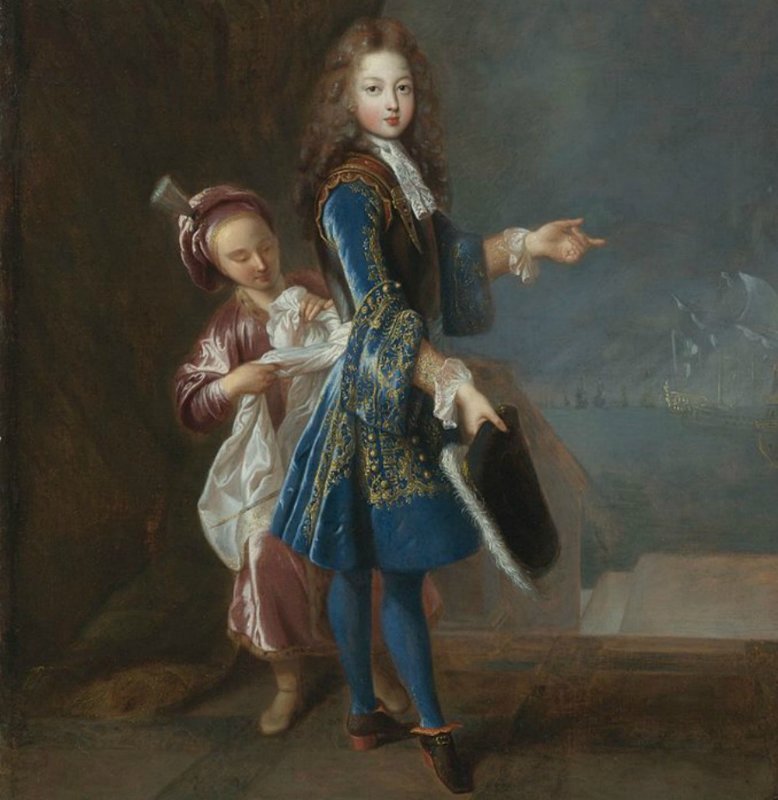LOUIS ALEXANDRE DE BOURBON(1681-1737) A SON OF KING LOUIS XIV OF FRANCE.HE WAS KNOWN AS THE PRINCE OF LAMBALLE FROM BIRTH .HE PRE-DECEASED HIS FATHER,AND DIED CHILDLESS.
 Born in Versailles on 6 June 1678, teenager, dressed Novice of the Order of the Holy Spirit,acknowledged as legitimate and granted the title of Count of Toulouse on 22 November 1681.Appointed Admiral of France on 23 November 1683 ,Governor of Guyenne (January 1689),March-April 1691 Took part in the siege of Mons 1691 Madame de Montespan leaves the court,25 May – 30 June 1692 Siege of Namur,2 February 1693 Knight of the Order of the King,28 August 1693 Commander in Chief of the Toulouse-Cavalerie regiment,5 May 1694 Ranked after the princes of the blood and before the duke-peers,3 August 1697 Lieutenant General of the Royal Armies.
Born in Versailles on 6 June 1678, teenager, dressed Novice of the Order of the Holy Spirit,acknowledged as legitimate and granted the title of Count of Toulouse on 22 November 1681.Appointed Admiral of France on 23 November 1683 ,Governor of Guyenne (January 1689),March-April 1691 Took part in the siege of Mons 1691 Madame de Montespan leaves the court,25 May – 30 June 1692 Siege of Namur,2 February 1693 Knight of the Order of the King,28 August 1693 Commander in Chief of the Toulouse-Cavalerie regiment,5 May 1694 Ranked after the princes of the blood and before the duke-peers,3 August 1697 Lieutenant General of the Royal Armies.
Louis Alexandre de Bourbon was the third son and youngest child of Louis XIV born out-of-wedlock with Madame de Montespan. At birth, he was put in the care of Madame de Montchevreuil along with his older sister Françoise-Marie de Bourbon.Louis Alexandre was created Count of Toulouse in 1681 at the time of his legitimation, and, in 1683, at the age of five, grand admiral. In February 1684, he became colonel of an infantry regiment named after him and in 1693 mestre de camp of a cavalry regiment. During the War of Spanish Succession, he was given the task of defending Sicily. In January 1689, he was named governor of Guyenne, a title which he exchanged for that of governor of Brittanysix years later. On 3 January 1696, he was created a marshal of France, becoming commander of the royal armies the following year. During the War of the Spanish Succession he commanded the French fleet at the Battle of Vélez-Málaga in 1704.Though his father had legitimated him and his three surviving siblings, and even declared his two sons by Madame de Montespan fit to eventually succeed him to the throne of France, this was not to be, as immediately after Louis XIV's death the Parlement of Paris reversed the king's will.Unlike his brother, Louis Auguste, Duke of Maine, who was barred from the regency council, Toulouse was not kept from a political role, and soon after, he was named (minister of the Navy), inheriting a seasoned staff headed by Joseph Pellerin. He remained in this capacity until being succeeded by Joseph Fleuriau d'Armenonville in 1722, the same Fleuriau d'Armenonville who had sold him the castle of Rambouillet in 1706.He married Marie-Victoiré-Sophie de Noailles, marquise de Gondrin, who was considered one of the most beautiful and intelligent women of the court and who presided over a famous salon. The proposal of his marriage to Charlotte de Lorraine, Mademoiselle d'Armagnac, member of a cadet branch of the House of Guise had met with the categorical refusal of Louis XIV.His father had made his illegitimate children princes of the blood, giving them preference and ranking over other nobles, an act that caused great dissension among the aristocracy. Although Toulouse was a partisan of the Duc de Maine, his brother, he did not interest himself enough in court intrigues, and remained a member of the council of regency (1715–23), which gave him approval to rebuild the navy.
 On 2 February 1723, the comte de Toulouse married Marie Victoire de Noailles, a daughter of the Anne Jules, duc de Noailles, in a private ceremony in Paris. She was the widow of Louis de Pardaillan de Gondrin (1688-1712), his nephew, son of his half-brother Louis Antoine de Pardaillan de Gondrin, whose mother was Madame de Montespan. The marriage was kept secret until the death of the regent. The couple had one son:Louis Jean Marie de Bourbon, Duke of Penthièvre (1725–1793).Countess, Duchess. Marie Victoire Sophie de Noailles, daughter of Anne Jules de Noailles, second Duke of Noailles, and his wife Marie Françoise de Bournonville, was born at Versailles.
On 2 February 1723, the comte de Toulouse married Marie Victoire de Noailles, a daughter of the Anne Jules, duc de Noailles, in a private ceremony in Paris. She was the widow of Louis de Pardaillan de Gondrin (1688-1712), his nephew, son of his half-brother Louis Antoine de Pardaillan de Gondrin, whose mother was Madame de Montespan. The marriage was kept secret until the death of the regent. The couple had one son:Louis Jean Marie de Bourbon, Duke of Penthièvre (1725–1793).Countess, Duchess. Marie Victoire Sophie de Noailles, daughter of Anne Jules de Noailles, second Duke of Noailles, and his wife Marie Françoise de Bournonville, was born at Versailles.

